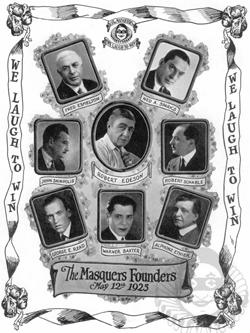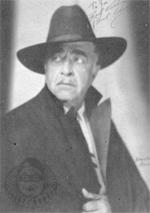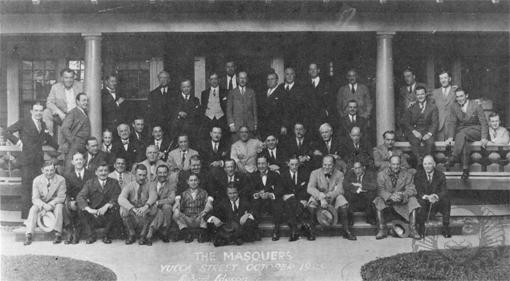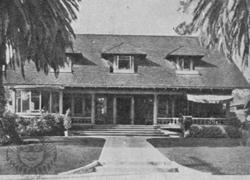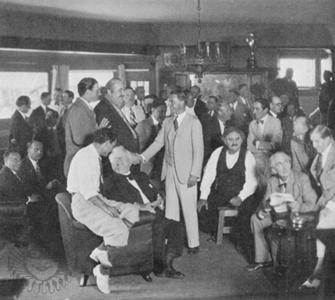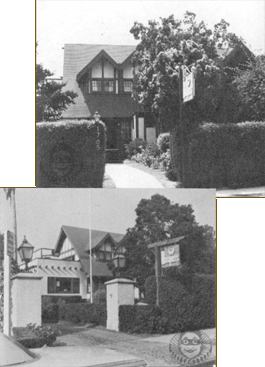 |
|||||||||||||||||||||||||||||||||||||||||||||||||||
A Club Is Born > The Year of Our Birth
How did The Masquers Club get its start? Just who was responsible for it all, anyhow? Mr. George Read, one of the founders, and a lengthy clipping from the Hollywood News of June 30, 1931, tells of our borning. To quote Mr. Read in part: "Prior to the founding of The Masquers, several abortive attempts had been made to form an actors' club here. One of these was the ill-fated "Bears Club" that was ultimately killed off by some 'interests.' "Then a promoter of Clubs from the east started a money-making deal (for himself) called, I believe, the Screen Actors Club. I was taken for $250 membership - then found that the "Club" owned (!) the old Japanese Embassy building in Hollywood, saddled with a $90,000 mortgage. Without my knowledge, I was made a member of the board of directors - and when I found what we were up against, I suggested to the other board members that we order the Club disbanded - which was done. "The 'board' then walked out on the porch. There was Bob Edeson, Fred Esmelton, Alfonz Ethier and myself. I did a little cussing and remarked that Hollywood certainly needed an actors' or theatrical club like The Lambs, but I felt sure that The Lambs did not start out with a swank clubhouse and a big mortgage. Bob said, indeed not, that it started with a couple of rented rooms."
There was no hesitation, no lack of decision. Each man was thoroughly sold on the idea. It was all now a matter of determining the first steps. "A club should be just like a courtship," stated Ethier. "If there is enough love, there is no need for money." "You win!" announced Ned Sparks, who had joined the group. "Make it a club founded on love!" "That's it" fairly shouted Edeson, "A Club of love and loyalty and laughter. We'll laugh to win!" And he held out his hand toward the others. Each man unctuously extended his hand. Without premeditation, the five hands met - and clasped. They were as one. For an instant, there was a complete silence. Then Bob repeated, "A Club of love, loyalty and laughter - that's it! We'll laugh to win!"
"We'll laugh to win!" said all of them in unison. And to this very day, "We Laugh to Win" is the motto of the organization. Now came the problem of organizing, a clubhouse, dues, rules and the incorporation... and the big question: Could they get members? Two of the men, Read and Esmelton, wanted to look over an old house on Yucca street. Finding it locked they climbed in thru an open window. Within a few minutes, two policemen arrived, but a situation was averted when one of the police recognized Read. A couple of days later, the "board" walked up to the house (with key in hand), inspected it throughout and sat on the stairs and talked. The first formal meeting was on the next day, May 5, 1925. Sitting on orange crates, they discussed their problems. On May 18, another meeting was held, this time with 30 members. Among these was Ingle Carpenter, an attorney, formerly from the east. He told the members the necessity of being properly incorporated and offered to look after the legal work, gratis.
Then came the choosing of a name. After days of argument and debate, a suitable one was suggested. The club would be known as "The Jesters." But no sooner had the wheels started rolling than an objection came from the Shriners. It seems that The Jesters was one of the unincorporated organizations in the Shrine. Another meeting was held, this time over 100 members and, at the suggestion of Earle Foxe, the name "Masquers" was adopted. Now the work was to begin. "The following week many things were happening" reads the Hollywood News. "Cyril Chadwick was a volunteer foreman for the cleaning and painting crew. Actors who received hundreds, perhaps thousands of dollars weekly for their professional services, were busy with brooms, scrubbing brushes and painting equipment. Of course, these men could have donated enough money to have everything done but they elected to do it themselves. It was just the spirit of The Masquers asserting itself. "Meanwhile, Esmelton, assisted by Ethier, purchased heavy oak tables, chairs and benches. These were followed by cutlery, dishes and other similar necessities. It wasn't long until there was a completely furnished and well decorated house -- with a kitchen and ice box -- even remotely approaching food. "Everything was quite peaceful and serene until a couple of men who had seen service in France turned loose the familiar old army cry, 'when do we eat?' "The first luncheon was a glorious affair. Esmelton, who had long been famous in both the theatrical and motion picture professions for his ability in preparing exquisite and delightful foods, prepared the first luncheon -- and it was the greatest sort of a success. It was so much of a triumph that he became the official non-salaried cook --- and he remained on the difficult job until The Masquers was averaging more than 100 luncheons a day. "Finally, it became necessary to hire a club manager and steward. The dining room became too small for the crowd, so a roof garden was constructed, and was packed to capacity each day. And everybody knew everybody else, intimately, delightfully. It was bad form, and not at all the true Masquers spirit not to know a brother Masquer quite well enough always to address him by his first name."
"The whole thing got off to a wonderful start," writes Mr. Read "and a wonderful spirit --- from the very beginning. Masquers gave freely of their time, furniture, money and ideas. It just couldn't go wrong!! Fred Esmelton worked like a dog and watched every nickle for the first 2 or 3 years, and I did what I could to keep our finances on an even keel as Treasurer. We rocked along pretty well until Sam Hardy came along, and then that great guy put on big shows, made pictures and generally raised hell to give us a large chunk of money, which put us on a permanently sound basis." So here we are! "We Laugh to Win." "Man is the only animal that laughs and weeps, for he is the only animal that is struck with the difference between what things are, and what they ought to be." William Hazlitt (1788-1830) Some further insights into the origins of our motto "We Laugh To Win" are offered here.
Sweet wind, fair wind, The bottom of the chart had been torn but it is widely held to be the work of Robert Louis Stevenson. From an old friend, Masquer Kay E. Kuter, comes another possible derivation. He referred us to Othello's speech in Act IV, Sc I, Line 123. --- "So, so, so, so:It seems probable to us that Robert Edeson, our first Harlequin, who received his early stage training from his producer-manager father, and who himself was a Broadway star at twenty-one, could have been unconsciously paraphrasing either of the above quotes (which no doubt he was more than familiar with) when he embraced the other founding fathers and excitedly declaimed on that night 50 Golden years ago, "That's it! A Club of love and loyalty and laughter. We'll laugh to win!" The Year of Our Birth by Allan Hersholt (Harlequin 1967-1969) 1925 found Hollywood with a population of 130,000... The reigning stars of the day were Fairbanks, Pickford, Valentino, Lloyd, Chaplin, Swanson, Negri, the Talmadge sisters, Colleen Moore, Barthelmess, Corinne Griffith and the Gish girls... Charles Farrell was supporting Rin Tin Tin at Warner Bros.... Janet Gaynor was doing bits at Fox... The average number of feature films annually was 700... And radio was being blamed for an alarming decline in movie box office receipts... Perhaps the most exciting and colorful event of the year was Fred Niblo's filming of the Chariot Race for the $4,000,000 "Ben-Hur". The coliseum set was built on a huge open lot at Venice Blvd and La Cienega at a cost of $300,000, and forty-two cameras were used to record the memorable sequence... In Rome, Mussolini issued an edict that for one week bimonthly all Italian theatres must show Italian films exclusively... Back in Hollywood, Sid Grauman announced plans to erect "the most picturesque and unique playhouse in the entire world" - Grauman's Chinese Theatre... It was estimated that there were 50,000 movie houses in the world - 20,000 of them in America... And two more were soon to be added. In New York, Adolph Zukor announced plans to erect the Paramount Theatre on the site of the old Putnam Building in Times Square, and Sam Rothafel launched construction of the Roxy Theatre... Meanwhile Warner Bros., of the lesser companies, joined with Western Electric and its research unit, Bell Laboratories, to develop and promote the Western Electric sound system, which they labeled Vitaphone... That year Will Rogers took his first flight in an airplane. His pilot was Billy Mitchell... MGM hired a Swedish actress named Garbo at a salary of $400 a week... Irving Thalberg's salary at the same studio was raised from $650 to $2,000 weekly... Paramount signed D. W. Griffith at $156,000 a year... Fox was paying Tom Mix $17,000 a week... And Jesse Lasky offered Gloria Swanson a Paramount contract at $18,000 weekly for seven years, but she declined to produce independently... The Charleston became the dance of the day. And dancer George Raft was helping to popularize it at Texas Guinan's in New York... In Hollywood, Paramount had Thelma Todd among the students... Clark Gable was working as an extra in Mae Murray's "Merry Widow"... Douglas MacLean (our next Harlequin) starred in "Seven Keys to Baldpate" for Paramount... Reginald Denny was Universal's top box-office draw... Gary Cooper was doing bits in westerns... Vitagraph sold out to Warners that year... C. B. demille left Paramount to make pictures for Producers Distributing Corp.... Joe Schenck's efforts to merge United Artists with MGM were upset by partner Charlie Chaplin's disapproval... Chaplin's "Gold Rush" had its world premiere at Grauman's Egyptian, with Fred Niblo serving as master of ceremonies. This was said to be the longest and costliest comedy ever made. It ran nine reels, and many critics complained of its "extreme" length... In New York, the Durant Club was headlining Clayton, Jackson " Durante, and charging $25 for a quart of wine... Edward Arnold appeared with Otto Kruger and Victor Moore in "Easy Come, Easy Go" at the Biltmore there... Al Jolson was in "Big Boy" at the Winter Garden... Fred and Adele Astaire, Walter Catlett and Cliff Edwards were in "Lady, Be Good!" at the Liberty... Also on the Broadway boards: W. C. Fields in "Poppy", Fred and Dorothy Stone in "Stepping Stones", and Eddie Cantor in "Kid Boots"... That year William Fox began developing what was later to be known as Fox Movietone... Tony Moreno was a Paramount star... Lucille Le Sueur became Joan Crawford... Luis Alonso became Gilbert Roland... Buster Keaton made the unforgettable "Go West" ...... Larry Semon, Oliver Hardy and Dorothy Dwan starred in "The Wizard of Oz"... Ronald Colman and Vilma Banky teamed in Goldwyn's "Dark Angel"... Reed Howes, famed as the "Arrow Collar Man", appeared in Warner's "Bobbed Hair"... Doug Fairbanks, after several years of experimentation, started production on an all-color picture, "The Black Pirate"... Bing Crosby was working as a song and dance man for Fanchon & Marco at $60 a week... Lew Cody co-starred with Norma Shearer in MGM's "Slave of Fashion"... Douglas Shearer, her brother, got a job as a prop man at Warners... Jack Dempsey married Estelle Taylor, and Edmund Lowe married Lilyan Tashman... Leon Errol was in "Clothes Make the Pirate" at First National... Jack Mulhall teamed with Dorothy Mackaill in "Joanna" at the same studio... Buck Jones' leading lady was Jane Peters, who later became Carole Lombard... Mary Astor was soon to be proclaimed a Wampas Baby Star... And Lee Francis and Polly Adler were outgrossing Metro and Paramount.  |
|||||||||||||||||||||||||||||||||||||||||||||||||||







